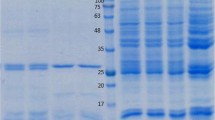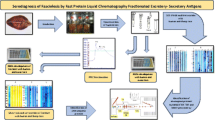Abstract
Somatic antigens of F. gigantica, G. explanatum, S. spindale and hydatid cyst ingredients were analysed to identify the cross-reactive antigens among them using Western blot technique. When probed with F. gigantica infected cattle sera, the immunodominant 156 kDa and 28 kDa proteins of F. gigantica was found common amongst the antigens prepared from hydatid cysts ingredients like germinal layer, fertile and sterile, hydatid fluid, fertile and sterile, while another protein of 34 kDa was shared between F. gigantica and antigen prepared from protoscolices. In F. gigantica–buffalo system the proteins of 34 kDa and 28 kDa were found reactive with most of the antigens tested. Immunoaffinity chromatography using, F. gigantica infected rabbit immunoglobulins as legands isolated the immunodominant 34 kDa and 28 kDa proteins in dimer form and the same were found immunodominant in F. gigantica–cattle, F. gigantica–buffalo and F. gigantica–sheep system. No cross-reaction was noted with the sera of goats experimentally infected with Paramphistomum epiclitum. ELISA with the immunodominant proteins of 34 kDa and 28 kDa could be a feasible diagnostic tool for the early detection of bovine fasciolosis.








Similar content being viewed by others
References
Aiken A, Learmoth M (1996) Protein determination by UV absorption. In: Walker JM (ed) The protein protocols hand book. Humama Press, Totowa, NJ
Aronstein WS, Dalton JP, Strand M (1985) A Schistosoma mansoni surface glycoprotein cross-reactive with a T1 antigen of Fasciola hepatica. Am J Trop Med Hygiene 34:889–897
Aronstein WS, Lewis SA, Norden AP, Dalton JP, Strand M (1986) Molecular identity of a major antigen of Schistosoma mansoni which cross-reacts with Trichinella spiralis and Fasciola hepatica. Parasitology 92:133–151
Attallah AM, Karawia EA, Ismail H, Tabll AA, Nawar AA, Ragab WA, Abdel Aziz MM, El-Dosoky I (2002) Identification and characterization of a 26–28 kDa circulating antigen of Fasciola gigantica. Ann Trop Med Parasitol 96(3):271–282
Cornelissen JB, Gaasenbeek CP, Borgsteede FH, Holland WG, Harmsen MM, Bocrsmo WJ (2001) Early immuno diagnosis of fasciolosis in ruminants using recombinant Fasciola hepatica cathepsin L-like protease. Int J Parasitol 31:728–737
Delgado C, Rosengrant M, Steinfeld H, Ehui S, Courbois C (1999) Livestock to 2020. The next food revolution. Discussion Paper 28. International Food Policy Research Institute, Washington, DC
Dixit AK, Yadav SC, Sharma RL (2002) 28 kDa Fasciola gigantica cysteine proteinase in the diagnosis of prepatent ovine fasciolosis. Vet Parasitol 109:233–247
Fabiyi JP (1987) Production losses and control of helminths in ruminants of tropical regions. Int J Parasitol 17:435–442
Fagbemi BO and Guobadia EE (1995) Immunodiagnosis of fasciolois in ruminants using a 28-kDa cysteine protease of Fasciola gigantica adult worms. Vet Parasitol 57:309–318
Fagbemi BO, Obarisiagbon IO, Mbuh JV (1995) Detection of circulating antigen in sera of Fasciola gigantica infected cattle with antibodies reactive with a Fasciola-specific 88 kDa antigen. Vet Parasitol 58:235–246
Fey H, Pfister H, Messerli J, Sturzenegger N, Grolimund F(1976) Methods of isolation, purification and quantitation of bovine immunoglobulins: a technical review. Zentrablatt Vet Med 23:269
Ghosh S, Preeti Rawat, Velusamy R, David Joseph, Gupta SC, Singh BP (2005) Diagnostic efficacy of a 27 kDa glycoprotein in early diagnosis of Fasciola gigantica infection in cattle. Vet Res Commun 29:123–135
Guobadia EE, Fagbemi BO (1996) Detection of circulating Fasciola gigantica antigen in experimental and natural infections of sheep with fasciolosis. Vet Parasitol 65:29–39
Guobadia EE, Fagbemi BO (1997) The isolation of Fasciola gigantica-specific antigens and their use in the serodiagnosis of fasciolosis in sheep by the detection of circulating antigens. Vet Parasitol 68:269–282
Gupta SC, Yadav SC (1993) Fasciola gigantica: somatic and excretory and secretory antigens in the diagnosis of experimental fasciolosis. Ind J Anim Sci 63:1025–1027
Hillyer GV, Solar de Galanes M, Rodriguez-Perez J, Bjorland J, Silva de Lagrava MS, Ramirez-Guzman S, Bryan R(1992) Use of the Falcon assay screening test–enzyme-linked immunosorbent assay (FAST–ELISA) and the enzyme linked immunosorbent assay (ELISA) to determine the prevalence of human fasciolosis in the Bolivian Altiplano. Am J Trop Med Hygiene 46:603–609
Intapan PM, Maleewong W, Nateeworanart S, Wongkham C, Pipitgool V, Sukolapong V, Sangmaneedet S (2003) Immunodiagnosis of human fasciolosis using an antigen of Fasciola gigantica adult worm with the molecular mass of 27 kDa by a dot ELISA. Southeast Asian J Trop Public Health 34(4):713–717
Laemmli UK (1970). Cleavage of structural proteins during assembly of the head of bacteriophage T4. Nature 227:630–684
Lal RB, Ottensen EA (1989) Phosphocholine epitopes on helminth and protozoal parasites and their presence in the circulation of infected human patients. Trans Roy Soc Trop Med Hygiene 83:652–655
Lowry OH, Rosenbrough NJ, Farr AL, Randael RJ (1951) Protein measurement with the Folin–phenol reagent. J Biol Chem 193:265–275
Mbuh JV, Fagbemi BO (1996) Antibody and circulating antigen profiles before and after chemotherapy in goats infected with Fasciola gigantica.Vet Parasitol 66:171–179
Nei M, Li WH (1979) Mathematical model for studying the variation in terms of restriction endonucleases. Proc Nat Acad Sci USA 76:5269–5273
Rao JR, Yadav SC, Ram GC, Raghav PRS, Lal RB (1996) Common antigenic determinants of Fasciola gigantica as defined by monoclonal antibodies to phosphocholine. J Appl Anim Res 9:95–104
Shephard JC, Mc Manus DP (1987) Specific and cross-reactive antigens of Echinococcus granulosus hydatid cyst fluid. Mol Biochem Parasitol 25:143–154
Sloan T, Dooge D, Joyce P (1991) Identification of phosphorylcholine containing antigens of Fasciola hepatica—successful tolerization against this epitope in experimental animals. Parasite Immunol 13:447–455
Soulsby EJL (1982) Helminths, arthropods and protozoa of domesticated animals. Bailliere, Tindall, London, p 809
Spithill TW, Piedrafita D, Smooker PM (1997) Immunological approaches for the control of fasciolosis. Int J Parasitol 27:1221–1235
Towbin H, Staehelin T, Gordon J (1979) Electrophoretic transfer of proteins from polyacrylamide gels to nitrocellulose sheets: procedure and some applications. Proc Natl Acad Sci USA 76:4350–4354
Wuhrer M, Grimm C, Dennis RD, Idris MA, Geyer R (2004). The parasitic trematodes Fasciola hepatica exhibits mammalian-type glycolipids as well as Gal(β1–6) Gal-terminating glycolipids that account for cestode serological cross reactivity. Glycobiology 14(2):115–126
Acknowledgements
The authors are grateful to the Indian Council of Agricultural Research for providing fellowship to the senior author. Part of the work was conducted under World Bank funded National Agricultural Technology Project. The experimental animals comply with the current laws of the country in which the experiments were performed.
Author information
Authors and Affiliations
Corresponding author
Rights and permissions
About this article
Cite this article
Yokananth, S., Ghosh, S., Gupta, S. et al. Characterization of specific and cross-reacting antigens of Fasciola gigantica by immunoblotting. Parasitol Res 97, 41–48 (2005). https://doi.org/10.1007/s00436-005-1371-1
Received:
Accepted:
Published:
Issue Date:
DOI: https://doi.org/10.1007/s00436-005-1371-1




